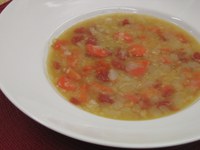Prairie Fare: Lentils Are Heart-healthy, Budget-friendly Ingredients
(Click an image below to view a high-resolution image that can be downloaded)
By Julie Garden-Robinson, Food and Nutrition Specialist
NDSU Extension Service
The other day I followed my nose to the garlic and onions sautéing in a pan on the stove in the food preparation lab.
“What kind of soup are you making?” I asked one of my students who was testing recipes for a project we are completing.
“That’s the red lentil soup,” she replied while stirring the aromatic onions.
I noticed some freshly juiced lemon juice in a cup and other ingredients simmering in a pot on the stovetop. When the recipes were ready, I scooped a bit of the soup in my bowl.
The soup had a savory broth with a slight lemony flavor. Our guest taste testers were commenting on the soup and asking for the recipe. I went back and filled my bowl half-full the second time. Other people came up for seconds.
I became somewhat of a “soup hoarder.” I returned again and dished the second half of my serving. The good news for you: I’m featuring the recipe this week.
Although I like lentils, sometimes I forget how easy they are to prepare and how versatile they can be on menus. Lentils are a nutritional bargain. Not only are they an inexpensive source of protein, but they are notable sources of fiber, potassium, folate (a B vitamin), iron and several other vitamins and minerals.
One cup of cooked lentils has about 16 grams of fiber, which is about half of the daily fiber recommendation for most adults. Lentils provide soluble fiber, which may help reduce blood cholesterol levels and potentially lower our risk for heart disease.
Lentils are part of the “pulse” family, which also includes chickpeas and split peas. Unlike their cousins in the dry edible bean family, lentils do not require soaking prior to cooking. They soften with about 20 minutes of simmering.
Lentils have been used for thousands of years. Lentils have been found in archeological digs and in Egyptian tombs.
Lentils are widely used in Indian, Mediterranean and African cuisine. In India, a popular stew made of lentils and other ingredients is known as “dal.” Depending on where you live, you may find brown, red, black or yellow lentils.
You can use them in soups, stews, dips, breads and salads. Try adding some lentils to spaghetti sauce to boost the protein and fiber content.
Prior to cooking lentils, be sure to sort them and remove any small stones. Rinse them thoroughly and then follow the cooking directions on the package.
How about some lentil soup? At 170 calories for a steaming bowl of hearty soup, you may want to enjoy seconds. It also freezes well in meal-sized amounts.
For more information about nutrition, see http://www.ndsu.edu/eatsmart or the Prairie Fare blog at http://www.prairiefare.areavoices.com.
Red Lentil Soup
8 c. chicken broth, low-sodium
2 c. red lentils (dry)
4 medium carrots, diced
1/2 tsp. cumin
1/2 tsp. paprika
1 large onion, diced
1-2 cloves garlic, minced
2 Tbsp. olive oil
2 chicken bouillon cubes, low-sodium
1 (10-ounce) can diced tomatoes and green chilies
1 lemon, juiced (about 1/3 cup juice)
Fresh parsley (for garnish)
Optional: 1 c. diced roasted chicken
Sort, then rinse lentils. Add to broth and bring to a boil. Add diced carrots. Cover, cook for 30 minutes while stirring occasionally. When lentils are tender, add dry spices, bouillon cubes and diced tomatoes. Saute onions and garlic in a frying pan using olive oil. When golden brown, add to soup mixture. Add chicken if desired. Simmer for five minutes. Turn off heat and add lemon juice to pot, stir. Garnish bowls of soup with parsley if desired.
Makes 12 servings. Without chicken, each serving has 170 calories, 3 grams (g) of fat, 11 g of protein, 25 g of carbohydrate, 11 g of fiber and 160 milligrams of sodium.
(Julie Garden-Robinson, Ph.D., R.D., L.R.D., is a North Dakota State University Extension Service food and nutrition specialist and professor in the Department of Health, Nutrition and Exercise Sciences.)
NDSU Agriculture Communication – Feb 7, 2013
| Source: | Julie Garden-Robinson, (701) 231-7187, julie.garden-robinson@ndsu.edu |
|---|---|
| Editor: | Rich Mattern, (701) 231-6136, richard.mattern@ndsu.edu |




